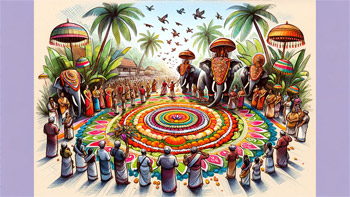Onam is a vibrant and significant festival celebrated by the people of Kerala, a state in the southern part of India. It marks the Malayalam New Year and is a harvest festival that brings together communities to celebrate life, culture, and traditions. Onam is not just a festival for the Hindus but has evolved to be celebrated by people of all religions in Kerala. The festival spans ten days, with each day having its own significance and set of rituals. The story behind Onam is deeply rooted in Hindu mythology, revolving around the beloved king Mahabali, whose spirit is said to visit Kerala during this time. The people of Kerala prepare a grand welcome for their cherished ruler with elaborate feasts, colorful decorations, and vibrant performances.
The essence of Onam is captured through its myriad of activities and rituals that showcase the rich cultural heritage of Kerala. The most notable among these is the Onam Sadya, a sumptuous vegetarian feast served on banana leaves and consisting of over 20 dishes. This feast is a culinary representation of Kerala's diversity and abundance. Another highlight is the Vallamkali, the snake boat races held on the backwaters of Kerala. These races are a spectacular sight, with hundreds of oarsmen rowing the long and slender boats to the rhythm of drums and cheering crowds.
Significance of Onam
Onam is deeply intertwined with the agrarian lifestyle of Kerala. It is celebrated at the end of August or the beginning of September, which coincides with the harvest season. This period marks the harvest of rice, the staple food crop of the state, and is a time of abundance and prosperity. The festival is a thanksgiving to the gods for the bountiful harvest. The mythical king Mahabali is central to Onam. According to legend, his reign was a golden era of prosperity, equality, and happiness. The celebration of Onam is a reflection of the wish for a return to this ideal state of being, where everyone is equal, and there is no sorrow or suffering.
The significance of Onam goes beyond its religious and cultural dimensions to encompass social harmony. It is a time when people from various communities come together to celebrate, transcending religious and social boundaries. This unity is reflected in the communal activities such as the making of Pookalam, floral carpets designed with precision and creativity on the ground in front of homes. The festival promotes a sense of community and togetherness, reinforcing the social fabric of Kerala.
Customs and Traditions
Onam is rich in customs and traditions, with each day of the festival having its unique practices and rituals. The first day, Atham, begins with the making of the Pookalam, which grows in size and complexity with each passing day. Another important tradition is the wearing of traditional attire; men wear the dhoti and women dress in the Kerala saree or Settu mundu, symbolizing purity and elegance.
One of the most anticipated events of Onam is the Thrikkakara Appan clay figures, which are worshipped during the festival. These figures represent Vamana, an avatar of Vishnu, and King Mahabali. Cultural programs, including classical dances, music performances, and drama, depict the story of Onam and showcase Kerala's rich artistic heritage. Children engage in traditional games, and families take part in boat races, adding to the festive spirit. The Onam Sadya is a pivotal part of the celebration, bringing families together to enjoy a meal that is both a gastronomic delight and a symbol of unity.
The Story of King Mahabali and Vamana
The legend of King Mahabali is at the heart of the Onam celebration. Mahabali, a generous and just Asura king, had gained so much power that he ruled over the earth and the heavens. The gods felt threatened by his growing power and popularity. To curb Mahabali's power, Vishnu took the form of a Brahmin dwarf, Vamana. During a great assembly, Vamana asked for three paces of land from Mahabali, who proudly granted this wish. Vamana then transformed into a giant form, covering the earth and the heavens in two steps. For the third step, Mahabali offered his head, showing his humility and devotion. Impressed by his devotion, Vishnu granted Mahabali a boon to visit his people once a year during Onam.
This story symbolizes the eternal conflict between pride and humility, the divine and the earthly realms. Onam celebrates the virtues of Mahabali - generosity, equality, and justice. The festival is a reminder of the importance of humility, compassion, and the need to stay grounded despite one's achievements or power.
Modern Celebrations
Today, Onam has transcended its traditional religious boundaries to become a universal festival of joy, celebrated by all Keralites regardless of their faith. Schools, colleges, and offices across Kerala organize special events and competitions, such as Pookalam contests, Onam Sadya, and cultural programs, to celebrate the festival. The government of Kerala promotes Onam internationally, showcasing the state's culture and tourism potential. Onam has become a global festival, with Keralites around the world celebrating it with the same fervor and enthusiasm as in Kerala.
Onam brings out the best of Kerala - its culture, traditions, and the spirit of unity. It is a time when the state is at its most beautiful, with nature and humanity coming together in a celebration of life. The festival, with its deep-rooted cultural significance and rich traditions, continues to be a beacon of hope, prosperity, and happiness, embodying the essence of a harmonious society.
